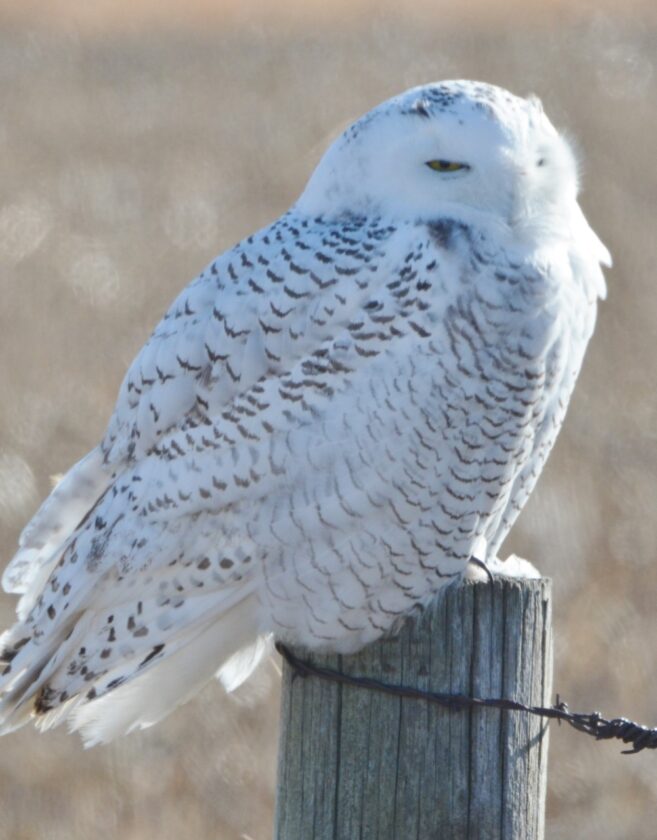PHOTOS BY GARRY BRANDENBURG — Enjoy this small sampling of wildlife images that add to the Christmas spirit of this special season. The real reasons for the season remain in these words: Christ was born, Christ died, Christ will come again.
By JOHN GARWOOD
It was a clear, cold and starlight night. A blanket of the whitest snow bedded down the valley of the Iowa … there were no lights from farms or villages … because there were no farms of villages … it was ‘most two thousand years ago!
Like the blanket of snow which covered the valley … a blanket of peace mantled the heavens … and each twinkling star seemed to send down a message to the wildlife of the valley. It was a special night and from the old snow owl in the highest tree to the muskrat splashing in an open ripple … all seemed aware of a difference.
A rabbit hopped from beneath a shelter of hazel brush. Sitting on his haunches, he nibbled bits bits of the sky with his nose … he knew that a fox was stalking his tracks … but on the “special” night, he had no fear … only peaceful security. Slowly he made his way to the top of the treeless hill … attracted by what … he did not know. The fox followed. Pausing at the crest of the hill, the rabbit sat up … and turned his head toward the east, where a bright and shining star shed its brilliant glow over the countryside. Behind him came the fox intent on the kill … then, too, he saw the star … and sitting down beside the rabbit he raised his head toward the sky.
From the shadowy woods, from the river and from the fields came the wildlife of the valley of Iowa. A doe and a fawn, a lumbering bear, two skulking wolves and white weasel … all took places in a great semicircle beside the fox and rabbit. All unaware of each other, they gazed at the great star in the east. From the river came the mink, the muskrat, the beaver and the otter. From the woods came the coon, the possum and the badger. A lynx and a skunk wandered the dame path leading to the hill, where they joined with the others in their vigil of the star. Then came the shaggy buffalo to join the silent group.
The brilliance of the star in the east wakened the birds of the valley ,,, and they, too, were attracted to the hill … the prairie chicken, the wild turkey and the quail roosted with the hawk and the owl … while far below in the valley, three wise old geese placidly rode the open ripples of the stream.
Swiftly and silently, along a game trail near the river, came a hunter. A flint axe swung from his belt. He was in search of food and fur for his wigwam. Seeing the many tracks leading from the river, he followed them upward to the hill. The light of the star cast a brilliance on the wildlife assembled there … and swiftly he bent an arrow to his bow and took aim on the nearest … the doe … then, too, he saw the star in the east and slowly lowered his arms. Gazing in wonder, he strode silently forward and took a place beside the buffalo.
From the river came the sound of the beating of strong wings as the three wise old geese took off from the waters. Circling slowly above the assembled birds, beast and hunter, they set a course toward the star in the east on a very special mission.
The hunter watched them until they could be seen no more … turning, he gazed at the wildlife about … slowly, he returned the arrow to the quiver … unstrung his bow … and silently strode away in the night … there was peace in the valley of the Iowa.

The late John Garwood was a longtime T-R contributor known for his “Sighting Upstream” column. John was one of the original appointees to the newly formed Marshall County Conservation Board that officially began its duties on July 1, 1958. He assisted in the formation of policies that lead to land acquisitions. That first land purchase dedicated to public use was Three Bridges County Park.
Two special remembrances are featured in today’s edition of Outdoors Today. As a short background and history lesson, the late John N. Garwood (1900-1992) wrote many short stories of his outdoor experiences, both in Marshall County and other faraway places.
John was a contributor to the Times-Republican for about 40 years. His Sighting Upstream column set the stage for my transition into writing for the TR, at first under the heading of Outdoor Reflections and later as Outdoors Today.
The Marshall County Conservation Board (MCCB) came into existence on July 1, 1958, a few years after the Iowa Legislature passed the enabling act in 1955. Slowly at first, various counties across Iowa set in motion the county government department known as County Conservation.
The need was to serve as an adjunct to the Iowa Conservation Commission that had a thinly spread system of state parks, wildlife areas, fishing access points and several unique state historical and botanical preserves. Far sighted conservation leaders of the 1940s and 50s envisioned a wide variety of local parks for outdoor recreation, fishing, hunting, and outdoor education. Each county in Iowa had their own special niches to fill.

The first MCCB members, five of them, were appointed by the Board of Supervisors. They were Richard Kemler, Ruby Kruse, Wilmer Handorf, Everett Dixson and John Garwood. To begin, the terms were staggered so that these first terms were one, two, three, four and five year appointments.
After that, a member could be reappointed by the Supervisors or a new person named to fill a full five year term. Many conservation minded citizens of Marshall County have served in this capacity during the last six plus decades. John Garwood served on the MCCB from July 1, 1958 and into the fall of 1961. He helped establish the first county park, Three Bridges.
John Garwood used his talents of writing about outdoor matters to promote conservation. He worked quietly, trying to encourage citizens to act responsibly toward their environment. His mythical Christmas story was one of his masterpieces.
The TR has reprinted his story every Christmas time during the last seven or eight decades. It is reprinted again for you today. Enjoy its symbology from the world of nature.
——–

Following is the tribute to John N. Garwood that I penned on March 19, 1992, a few days after Garwood’s passing away on March 16, 1992. I felt it appropriate to say goodbye to this former conservationist in special words from another conservationist. I hope you enjoy this little story in memory of John N. Garwood.
It was a cool, clear morning on the Iowa River. A light fog hung lazily in the shallow backwaters near the Iowa Veterans Home. The new morning soft sunlight was slowly being filtered by barren tree branches.
Dew drops rolled lazily off each swollen tree bud. His favorite wooden Old Town canoe, a bit scuffed and dirty but still water tight, lay upside down near the base of the tall cottonwood trees.
He’s walked down to his favorite stream, the Iowa River, to get in one last fishing trip.
With a fly rod in hand and a few pieces of tackle in an old match box, he turned the canoe over, wiped the grass off the paddle and loaded his pole into the craft. The canoe slid silently into the water and with a few deft strokes, the canoe cut a straight course for a clump of tangled tree branches packed tightly into a sharp bend of the Iowa from last year’s flooding.

The old deer tail fly was quickly tied on and with a few whips of the rod tip, the line and its barbless hook landed in a quiet eddy next to the snag. Slowly the fly drifted until a tiny jerk of the rod tip wiggled the fly.
An explosion of water broke the silence as a smallmouth bass hit the deer fly. The battle was on. Once next to the canoe, he reached down, grasped the line and admired the plump body of the fish. However, with one last burst of energy, the fish threw the hook and splashed back into the river unharmed.
John smiled and laughed quietly to himself as he guided his canoe around the next bend. It sure was good to be out on the river on a nice spring day.
Birds were singing everywhere. A few geese from Riverside Cemetery honked as they flew over the tall oaks. A doe hidden from view in the forest edge watched the canoe glide silently past her secluded spot.
A raccoon in an old soft maple den tree poked its head out of the hole to see the old man in the canoe. A Great Horned Owl sat deep in its branchy nest, warming eggs that will soon hatch. She watched the river pull at the canoe.
As the canoe drifted around the next bend in the river, he rested the paddle over his lap, set the fly down in front of him and slowly turned his head for one last time to sight upstream on his beloved Iowa River, and waved goodbye. There was peace in the valley of the Iowa.
——–
Quote: “Do what you can, with what you have, where you are.”
— Theodore Roosevelt
Garry Brandenburg is the retired director of the Marshall County Conservation Board. He is a graduate of Iowa State University with a BS degree in Fish & Wildlife Biology.
Contact him at:
P.O. Box 96
Albion, IA 50005
Credit: Source link




























